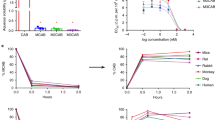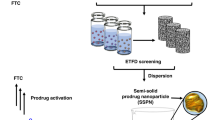Abstract
The human immunodeficiency virus (HIV) impacts up to 37 million people globally, of which 1.8 million are children. To date, there is no cure for HIV, although treatment options such as antiretroviral therapy (ART) are available. ART, which involves a patient taking a combination of antiretrovirals, is being used to treat HIV clinically. Despite the effectiveness of ART, there is currently no palatable pediatric formulation to treat HIV in children, which has hindered patient compliance and overall treatment efficacy. In addition, anti-HIV therapeutics are often poorly water-soluble, and hence have poor bioavailability. In the present study, we developed a pediatric-friendly formulation for anti-HIV therapeutics with improved dissolution characteristics of the therapeutic agents. Lopinavir (LPV) and ritonavir (RTV), available as FDA-approved fixed-dose combination products, were chosen as model ART drugs, and the formulation and processing parameters of spray-dried cyclodextrin (CD)-based LPV and RTV complexes were studied. Results showed that the spray-dried complexes exhibited enhanced dissolution profiles in comparison to pure drugs, particularly spray-dried β-CD complexes, which showed the most favorable dissolution profiles. This current formulation with enhanced dissolution and taste-masking ability through the use of cyclodextrin has the potential to address the unmet need for the development of suitable pediatric formulations.
Graphical abstract









Similar content being viewed by others
References
Nelson AG, Zhang X, Ganapathi U, Szekely Z, Charles W, Owen A, et al. HHS Public Access. J Control Release. 2016;219:669–80.
Mallipeddi R, Rohan LC. Progress in antiretroviral drug delivery using nanotechnology. Int J Nanomedicine. 2010;5:533–47.
Bhatti AB, Usman M, Kandi V. Current scenario of HIV/AIDS, treatment options, and major challenges with compliance to antiretroviral therapy. Cureus. 2016;8:1–12.
Pham K, Li D, Guo S, Penzak S, Dong X. Development and in vivo evaluation of child-friendly lopinavir/ritonavir pediatric granules utilizing novel in situ self-assembly nanoparticles. J Control Release. 2016;226:88–97.
Schlatter AF, Deathe AR, Vreeman RC. The need for pediatric formulations to treat children with HIV. AIDS Research and Treatment. 2016;2016:1654938.
Ivanovska V, Rademaker CMA, Van Dijk L, Mantel-Teeuwisse AK. Pediatric drug formulations: a review of challenges and progress. Pediatrics. 2014;134:361–72.
Chandwani A. Shuter J (2008) Lopinavir / ritonavir in the treatment of HIV-1 infection: a review. Ther Clin Risk Manag. 2008;4:1023–33.
Best Pharmaceutical’s for Children Act (BPCA). https://www.nichd.nih.gov/research/supported/bpca
Pittman DW, Brantly AM, Drobonick AL, King HT, Mesta DC, Richards CG, et al. The palatability of lopinavir and ritonavir delivered by an innovative freeze-dried fast-dissolving tablet formulation. AIDS Research and Treatment. 2018;5908167.
Saokham P, Muankaew C, Jansook P, Loftsson T. Solubility of cyclodextrins and drug/cyclodextrin complexes. Molecules. 2018;23:1–15.
Chay SK, Keating AV, James C, Aliev AE, Haider S, Craig DQM. Evaluation of the taste-masking effects of (2-hydroxypropyl)-β-cyclodextrin on ranitidine hydrochloride: a combined biosensor, spectroscopic and molecular modelling assessment. RSC Adv. 2018;8:3564–73.
Loftsson T, Hreinsdóttir D, Másson M. The complexation efficiency. J Incl Phenom Macrocycl Chem. 2007;57:545–52.
Brynn Hibbert D, Thordarson P. The death of the Job plot, transparency, open science and online tools, uncertainty estimation methods and other developments in supramolecular chemistry data analysis. Chem Commun. 2016;52:12792–805.
Thordarson P. Determining association constants from titration experiments in supramolecular chemistry. Chem Soc Rev. 2011;40:1305–23.
Molecular Operating Environment (MOE), 2019.01; Chemical Computing Group ULC, 1010 Sherbooke St. West, Suite #910, Montreal, QC, Canada, H3A 2R7, 2021
Goyal G, Vavia PR. Complexation approach for fixed dose tablet formulation of lopinavir and ritonavir: an anomalous relationship between stability constant, dissolution rate and saturation solubility. J Incl Phenom Macrocycl Chem. 2011;73:75–85.
Adeoye O, Conceição J, Serra PA, Bento da Silva A, Duarte N, Guedes RC, et al. Cyclodextrin solubilization and complexation of antiretroviral drug lopinavir: in silico prediction: effects of derivatization, molar ratio and preparation method. Carbohydr Polym. 2020;227:115287.
Del Valle EMM. Cyclodextrins and their uses: a review. Process Biochem. 2003;39:1033–46.
Baykal A, Bozkurt A, Jeremy R, Asiri SMM, Lima-Tenório MK, Kaewsaneha C, et al. Multistimuli-responsive magnetic assemblies. Advanced Nanocarriers for Therapeutics. 2019;2:155–93.
Rajbanshi B, Saha S, Das K, Barman BK, Sengupta S, Bhattacharjee A, et al. Study to probe subsistence of host-guest inclusion complexes of α and β-cyclodextrins with biologically potent drugs for safety regulatory dischargement. Sci Rep. 2018;8:1–20.
Wang CL, Zhou L, Zhang L, Xiang JF, Rambo BM, Sessler JL, et al. Discrete 1 : 1 complexes and higher order assemblies formed from aminobenzene sulphonate anions and a tetraimidazolium “molecular box.”. Chem Commun. 2017;53:3669–72.
Gryczke A, Langley N, Alshahrani SM, Park J-B, Alsulays BB, Majumdar S, et al. Stability-enhanced hot-melt extruded amorphous solid dispersions via combinations of Soluplus® and HPMCAS-HF. AAPS PharmSciTech. 2015;16:824–34.
Thakral NK, Zanon RL, Kelly RC, Thakral S. Applications of powder X-ray diffraction in small molecule pharmaceuticals: achievements and aspirations. J Pharm Sci. 2018;107:2969–82.
Sakuma S, Matsumoto S, Ishizuka N, Mohri K, Fukushima M, Ohba C, et al. Enhanced boosting of oral absorption of lopinavir through electrospray coencapsulation with ritonavir. J Pharm Sci. 2015;104:2977–85.
Gallicano K. Antiretroviral-drug concentrations in semen. Antimicrob Agents Chemother. 2000;44:1117–8.
Alopaeus JF, Hagesæther E, Tho I. Micellisation mechanism and behaviour of soluplus®–furosemide micelles: preformulation studies of an oral nanocarrier-based system. Pharmaceuticals. 2019;12:1–23.
Karagianni A, Kachrimanis K, Nikolakakis I. Co-amorphous solid dispersions for solubility and absorption improvement of drugs: composition, preparation, characterization and formulations for oral delivery. Pharmaceutics. 2018;10:98.
Funding
This work was supported in part by the IPEC-Americas Foundation Emerging Researcher Award and the Institutional Development Award (IDeA) Network for Biomedical Research Excellence from the National Institute of General Medical Sciences of the National Institutes of Health under the grant number P20GM103430. The SEM and XRD data was acquired at the RI Consortium for Nanoscience and Nanotechnology, a URI College of Engineering core facility partially funded by the National Science Foundation EPSCoR, Cooperative Agreement #OIA-1655221.
Author information
Authors and Affiliations
Contributions
Ryan Ivone (first author): (1) the conception and design of the study; (2) acquisition of data; (3) analysis and interpretation of data; (4) drafting the article; (5) revising it critically for important intellectual content.
Ashvin Fernando: (1) acquisition of data; (2) analysis and interpretation of data; (3) final approval of the version to be submitted.
Brenton DeBoef: (1) analysis and interpretation of data; (2) final approval of the version to be submitted.
Samantha Meenach (corresponding author): (1) the conception and design of the study; (2) revising it critically for important intellectual content; (3) final approval of the version to be submitted.
Jie Shen (corresponding author): (1) the conception and design of the study; (2) revising it critically for important intellectual content; (3) final approval of the version to be submitted.
Corresponding authors
Ethics declarations
Conflict of Interest
The authors declare no conflicts of interest.
Additional information
Publisher’s Note
Springer Nature remains neutral with regard to jurisdictional claims in published maps and institutional affiliations.
Supplementary Information
ESM 1
(DOCX 2748 kb)
Rights and permissions
About this article
Cite this article
Ivone, R., Fernando, A., DeBoef, B. et al. Development of Spray-Dried Cyclodextrin-Based Pediatric Anti-HIV Formulations. AAPS PharmSciTech 22, 193 (2021). https://doi.org/10.1208/s12249-021-02068-w
Received:
Accepted:
Published:
DOI: https://doi.org/10.1208/s12249-021-02068-w




